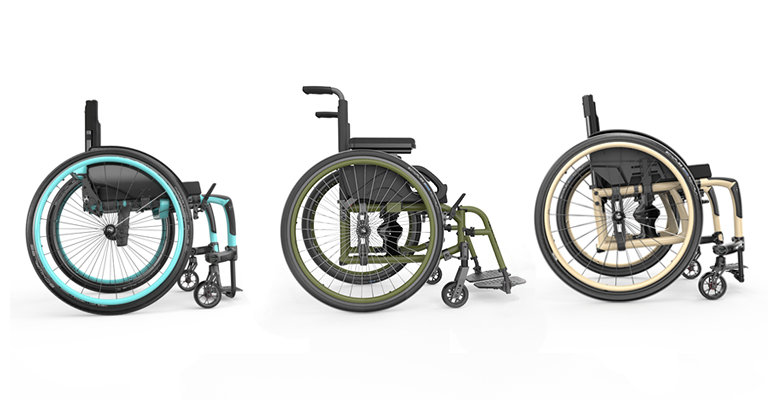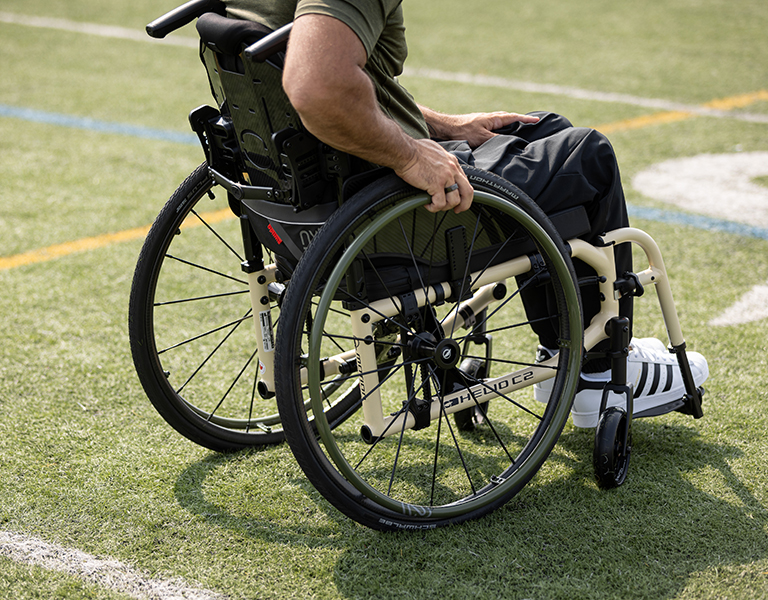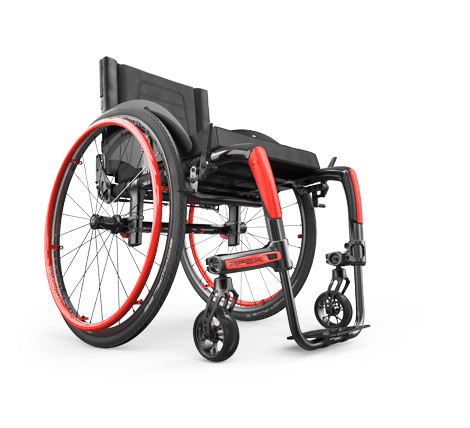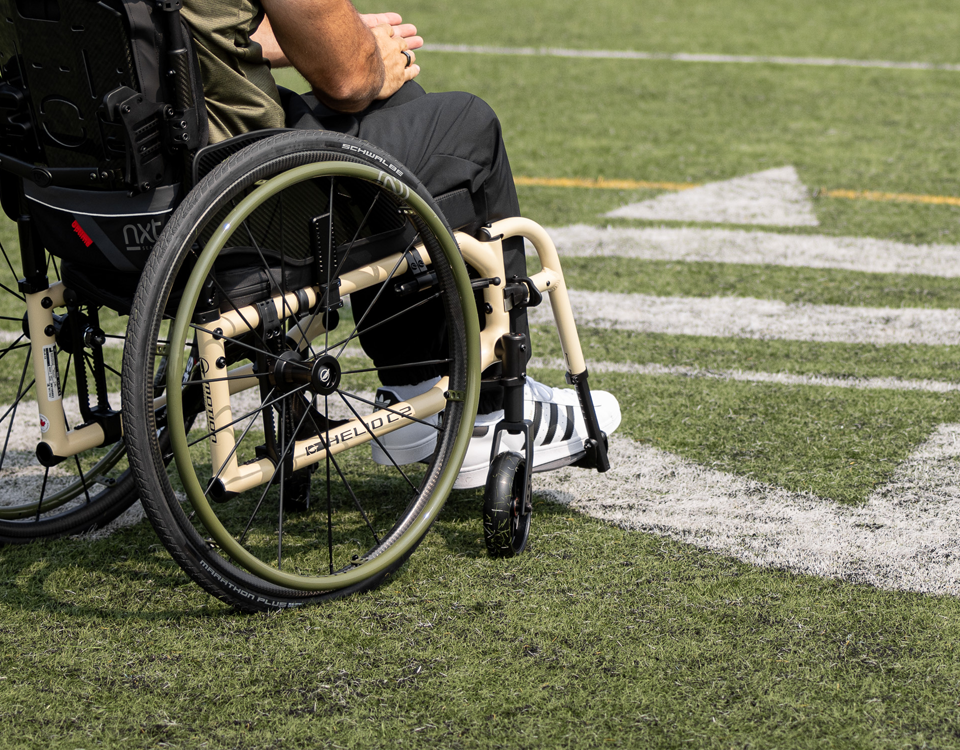Not that long ago, Mr. A came to our clinic because he was desperate to find someone that would help him get a new wheelchair. A year prior, he was evaluated by his home therapist along with an assistive technology professional (ATP) and a sales representative for a new wheelchair. This was a big change for Mr. A, as he had been slowly losing his ability to ambulate unassisted, and becoming more dependent with his activities of daily living (ADLs). It was very difficult for him to come to terms with the fact that he needed a mobility device to get around, and losing his independence felt as though he was a failure to himself and his loved ones. During his home evaluation, Mr. A recalled that no one asked him about his goals or needs. He noted he was lost in the assessment process because he did not understand the language and the jargon that his assessors were using. He remembered that he was only given a choice of color for his new wheelchair.
Due to multiple delays with documentation, funding, and processing queries, the delivery of Mr. A’s wheelchair was not scheduled until almost 1 year later. Unfortunately, not only was the wheelchair the wrong model and the wrong color, it did not match Mr. A’s size at all. Since there was nothing that the team could do to reconcile this at the appointment, Mr. A did not to accept the wheelchair at the time. Fortunately, the ATP scheduled a follow-up fitting to ensure that Mr. A got the correct equipment. Three follow-up visits later, it was deemed that the wheelchair could not, in fact, be fitted to Mr. A’s anatomy and match his functional needs since it was too small and could not be retrofitted to his size. Ultimately, the wheelchair was returned to the dealer and Mr. A’s insurance was not billed. Almost 15 months from his initial assessment, Mr. A found himself without equipment that he so desperately needed, and had to start from square one.
Most of us who work in Complex Rehabilitation Technology (CRT) have probably experienced a similar situation at some point in our practice. Some of us may also have been put in difficult situations when we had to try to remedy a complicated issue on someone else’s behalf. In any case, we should all be aware that effective communication skills are key to successful outcomes in the wheelchair service delivery.
Throughout my career, it has always been my priority to establish good communication and a healthy rapport with my patients and clients. No matter how short on time I am, I do my best to take the time to listen and take in what my client is saying because, I would want the same in return. Even a couple of minutes of a face-to-face encounter can make a big difference. Your clients will remember whether you looked them in the eye or whether you were glued to your computer during your interaction. They will remember the confirmatory nod or clarification questions.
It is so important to communicate with our clients throughout the entire process, ensuring to take time to listen and let them voice their needs and wants. You want to build a strong and honest rapport with your client to give them a sense of trust and let them know that you are someone they can rely on. Remember to also include the client’s caregiver or anyone else involved in the client’s care and decision making. Note that the goals of the client and caregiver may differ, so you need to be aware of who the decision maker is in this process.
Step By Step Process
While the focus of this article is on communication skills in wheelchair service delivery, the principles can be applied to any area of practice. We will review what encompasses good communication in each step of the wheelchair assessment process, not only for our clients, but for others involved in this service.
Referral
Get as much information as you can from the initial referral. If you receive any medical or treatment notes about your client, take the time to read them to familiarize yourself with your client prior to their visit. If the referral is unclear, reach out to the referring source to obtain the necessary information (or have someone contact them on your behalf – this could be the client’s doctor, social worker, or the client themselves).
Assessment:
Subjective/Client Interview
First impressions count! Introduce yourself! You may think this is common sense, but in my experience, I continue to be surprised by how many health care professionals do not say their name. They may briefly greet you, but then just get on with your appointment. Telling your client who you are and what you are there to do is part of the client’s consent. Similarly, in return, ask your client “Why are you here today?”, or “What brings you to our clinic?”, etc. You would be surprised how many times you will hear “I don’t know!” You want to clarify why they are there to see you. Review the past medical history and any information you learned from their referral notes. This will either confirm or refute their diagnosis, symptoms and/or the reason for their visit. The client will appreciate that you took the time to learn about them and it will help promote trust in you as well as trust in the process. Pay attention to what the client or their caregiver says – sometimes, there will be differing opinions, and you want to make sure to get everyone on the same page. If the client is non-verbal, you will most likely obtain the majority of the information from the caregiver. However, if your client has a communication device, let them use it – they have a voice, too! This may take more time, but letting your client express themselves can clarify any assumptions you may hold. Even body language can reveal a lot about the client’s needs – ask and confirm what it is they are trying to tell you. Are they in distress because they do not want to be there, they do not want a wheelchair, or are they simply in pain or discomfort?
Objective/Physical Assessment
Allow yourself ample time to do a thorough physical assessment. Often, we are pressed for time in the clinic and rarely have the luxury to schedule two separate appointments - but do so if you can, especially if you find that your client is physically and posturally challenging – e.g. requiring dependent transfers, limited tolerance to lying in supine, presenting with complex postural asymmetries, etc. Note if your client is showing discomfort throughout your physical assessment without knowing why. Ask them about your findings – e.g. “Did you know you have this curve in your spine that is causing you to lean to one side?” or “Did you know your pelvis drops on this side putting pressure under your buttocks during sitting?” Help them visualize what you are seeing – ask if they are comfortable using a mirror for feedback and if so, use it. Range of motion limitations, abnormal tone and movement, all cause discomfort or pain for the sensate client, so talk to them about what you are seeing and explain what and why it may be causing their symptoms. Sometimes your client and/or their caregiver may not be fully familiar with their diagnosis and the associated symptoms, so explaining to them why certain things happen may help them understand the reason as to what is going on with their body.
When assessing your client’s existing equipment, look at what they are using and watch how they are using it. If you see an odd accessory that does not seem to fit on the equipment, ask them why it is on their chair. Note a strangely placed seat cushion and lopsided back support? Inquire why it is positioned the way it is. You may be equally surprised by the reason or lack thereof!
Do not forget to utilize outcome measures wherever possible. While there are standardized measures available such as the Wheelchair Skills Test, you can utilize these however you want, (e.g. only test the several skills pertinent to your client) as long as you are consistent between your testing. Outcome measures will help you assess your client’s skills objectively and measure changes over time. Not only will these add value to your assessment, they can also provide excellent tools for your justification letter.
Equipment Trials and Recommendations
Utilize the entire Complex Rehabilitation Technology (CRT) team - have your assistive technology professional (ATP) and/or your local sales representative bring trial equipment. Even if the equipment is not the correct size or fit, the client will have a chance to see, trial, and test what options there are. Having the chance to trial products may confirm or refute the client’s needs and wants for their new equipment. With your expertise, it will help them make an informed decision about their technology/mobility device. Additionally, it is important to consider that more often than not, the brief trials that we do in the clinic do not allow our client to fully experience what the equipment would be like on a more permanent basis. Therefore, if you have the luxury to let the client do a home trial, please do. This could be as simple as a home visit with an ATP and/or a local sales representative if available. This way, the client can trial the equipment in their own familiar environment, which will further assist in deciding whether the device will truly meet their needs.

On the other hand, sometimes less is more. Giving your client too many options may confuse them, and they can become overwhelmed with too many choices or too much information. Narrow your trials down to what you believe will suffice (e.g. two types of rigid manual wheelchairs, two different seat cushions or back supports, etc.). Educate your client about the trial equipment and highlight how your choices will match their functional, postural, and mobility needs. If your client feels strongly about certain features and are convinced that something will not work for them despite your clinical recommendation, try what they believe they need or want to compare and help them make a decision. Sometimes we do not always agree, but we want to come to a conclusion that may be a good compromise between our clinical judgment and the client’s needs. Remember, it is ultimately the client who will use the equipment, not you.
If you have time, you want to include practicing transfers, propulsion, and other wheelchair skills with the trial equipment, especially if the client is new to wheeled mobility or if you are making significant changes to their device. You may find that the client does great with wheeling over level ground or even long distances, but they may struggle with inclines or uneven ground and may not be able to get their equipment into their car – which will greatly influence your final recommendations.
Documentation/Funding and Procurement
Proper documentation is key in CRT funding. If needed, you will want to write a concise letter of necessity with enough detail to justify funding for your particular client. Include objective tests or outcome measures wherever possible and the results of equipment trials. This will help you rule out lower level devices if customization is not possible on less expensive equipment. Include information on prior equipment, what worked, and what did not.
In some cases, objective tests do not give us the desired information to justify the need for a mobility device. Especially in cases where symptoms cannot be objectively measured unless tested over a period of time or several days, such as varying levels of fatigue and pain as in Ehlers-Danlos syndrome. You can ask for a diary of the client’s activities of daily living (ADLs) and their symptoms over a period of time, such as one full week. Since you may not be able to assess certain symptoms during your assessment, as you cannot predict what state of health your client will be during their visit, you can include a written example of how your client presents during a typical week from their perspective.
Prior to submitting your documentation, you will want to ensure that you have the client’s correct insurance information. Your ATP/sales representative can help inform your client about potential costs/copays for their equipment so that your client knows what to expect and can avoid any unpleasant surprises. You also want to ensure you let your client know what to expect in terms of timelines for approval or denial, how to handle any funding queries if needed, and what the timeline of delivery will be if funding is approved.
Fitting, Training and Delivery
Along with yourself as the clinician, the ATP/sales representative and even a technician should be involved in the fitting and delivery. Additionally, if the client has a caregiver, they should be included in this process so that they can learn about the client’s new device and be part of the training. Proper education about the client’s new device, including maintenance, assembly, training in propulsion, car transfers, and other wheelchair skills, is key to successful outcomes. Even if you had a chance to teach or review these skills during equipment trials, make sure your client knows how to do them with their new equipment. A long time may have passed since you did the trials, so a refresher never hurts. Watch the client’s expressions and reactions. Do not assume that when your client is quiet and/or does not ask questions that they know how to do things. Be aware that they may become overwhelmed if there is a lot of information thrown at them during delivery. Ask them to review what you discussed if you are not sure whether they understand. You can keep your training notes, documents or guides in an electronic format, and print them for your client as needed. This will greatly help with retention of information and serve as a useful reference for the client.

Follow-up Maintenance and Repair
At the conclusion of your delivery session, you will want to make sure your client and their caregiver know who to contact on the CRT team in case of any questions, concerns, or problems with their equipment. Reiterate that they should reach out anytime they have an issue, no matter how trivial it may seem. Reassure them that you are there for them and that your care did not just end with fitting and delivery. The client will always be in your care as long as they choose to, so let them know you are there for them anytime they need.
Being a good listener, communicating honestly and openly, being personable, and showing that you care and that you are passionate about helping your client will help facilitate an efficient assessment process and maximize successful outcomes. You are your client’s advocate - you want to empower their rights and decisions in this very important service. Try to put yourself in their shoes – it will make it easier for you to picture how you would like to be treated in that situation, and may help you handle difficult conversations or complex decision making. Do not be afraid to own up to your mistakes if anything goes wrong in the process – even if it was not directly your fault! Offer alternative solutions or compromises. Transparency in your communication will go a long way – your client may be upset initially, but will appreciate the honesty and alternative solutions you have to offer.
Last but not least – do not forget to make it a fun and memorable process not only for the client, but for the entire team!









